Ethiopian Opal: History, Symbolism, Meanings, and More!
 Opals come from all over the world, but many opal mining locales produce distinct, beautiful opals unlike any other. One African locale is where you can find the brightly colored Ethiopian opals, often called Welo opals.
Opals come from all over the world, but many opal mining locales produce distinct, beautiful opals unlike any other. One African locale is where you can find the brightly colored Ethiopian opals, often called Welo opals.
Many opal enthusiasts know Australia as the world’s opal capital, so are Ethiopian opals real? Definitely!
While roughly 95% of the world’s opals come from Australian mines, modern Ethiopian opal discoveries have put this African mine close behind Australia in terms of opal production and quality. Even more recently, an Ethiopian black opal played an essential role in the 2019 film Uncut Gems!
If you’re a beginner to the world of opals, you may only know this gem as the traditional October birthstone. Maybe you’ve heard about the “opal curse” or simply know the stone for its kaleidoscopic colors—but there’s so much more to learn, particularly about Ethiopian opals.
In this guide, you’ll discover the physical and spiritual Ethiopian opal properties, along with the history and symbolism behind these phenomenal gems!

What is Ethiopian Opal?
Ethiopian welo opal is a relatively new type of opal discovered in mountainous regions of northern Ethiopia, most importantly the Wollo Province.
What is the difference between opal and Ethiopian opal? Technically nothing, as Ethiopian opals are still opals, with the same 5.5-6.5 ranking on the Mohs mineral hardness scale. However, there are many different types of opals, the main categories being precious and common.
Precious opals are defined by their play-of-color, while common opals are any opals without color play. Ethiopian opals are valued for their vibrant play-of-color, which appears in numerous colors and patterns.
One distinguishing feature is that most Ethiopian opals are hydrophane, meaning their porous surfaces absorb water, shifting their appearance, size, and stability when submerged. These stones are opaque to translucent, like many opals, but Ethiopian opal in water becomes transparent!
In terms of color, Ethiopian opals come in several varieties, from solid colors like black, pink, or blue to rainbows of hues against various body tones.
That said, what are the different varieties of Ethiopian opal?
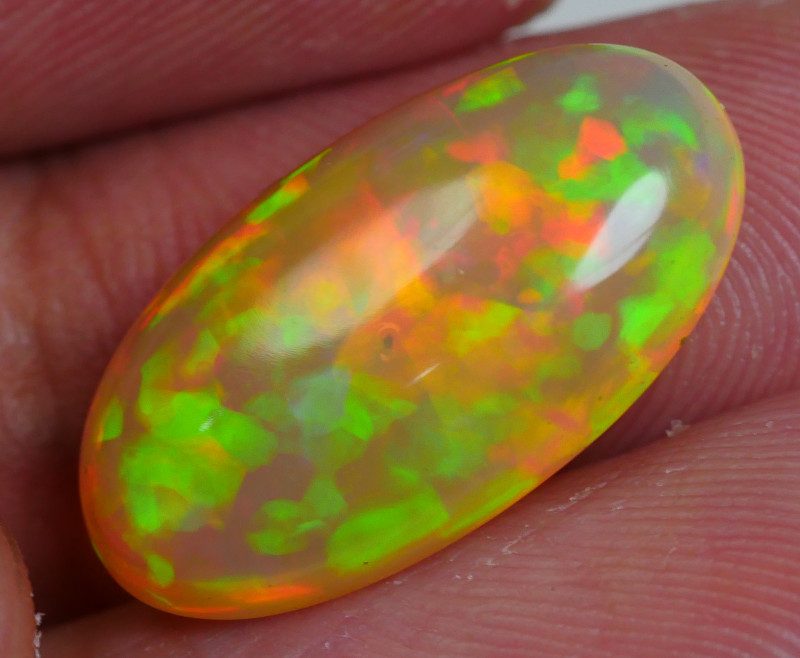
Types of Ethiopian Opal
All Ethiopian opals show play-of-color, but the body tone differs. The three key deposits (which we’ll cover more later) produce distinct varieties, including:
Precious Fire Opal: Abundant, translucent opals from the Wollo Province with the red, orange, or yellow body color of fire opals and play-of-color indicative of precious opal, often showing vibrant purple and green color flashes.
Black Opal: Rare naturally black opals that are not hydrophane, found in the Stayish mine of the Wollo Province, though many Ethiopian opals are treated to be black.
Shewa or Mezezo Opal: The first Ethiopian specimens discovered in 1994 in the Shewa province, typically reddish-brown, orange, or chocolate brown but often has problems with crazing—a type of damage where drying leads to web-like cracks.
White Precious Opal: Ethiopian opals with white body color, bright color play, and much better stability than Shewa opals. These are typically found near Wegel Tena.
These examples don’t cover every type of Ethiopian opal, as the number of body colors and patterns rivals that of Australian opals. Speaking of which, how are Australian and Ethiopian opals different?
The key differences between Australian vs. Ethiopian opals are that Ethiopian opals are usually larger, rarer, and less expensive than Australian opals.
One significant difference between Australian and Ethiopian opals is their formation processes, which we’ll discuss next!
Ethiopian Opal Gemstone Properties
Unlike Australian opal that forms deep underground, Ethiopian opal forms high up in the mountains. Volcanic activity is behind these hydrophane opals’ formation, and they come out nobby-formed (like lump-shaped balls) rather than seam-formed like most opals.
Once mined, it’s time to cut and value these opals—but how are they graded? Since the stone is new to the industry, Ethiopian opal grading is complex and somewhat subjective, but they’re generally graded on pattern, brightness, treatments, and color.
Pattern
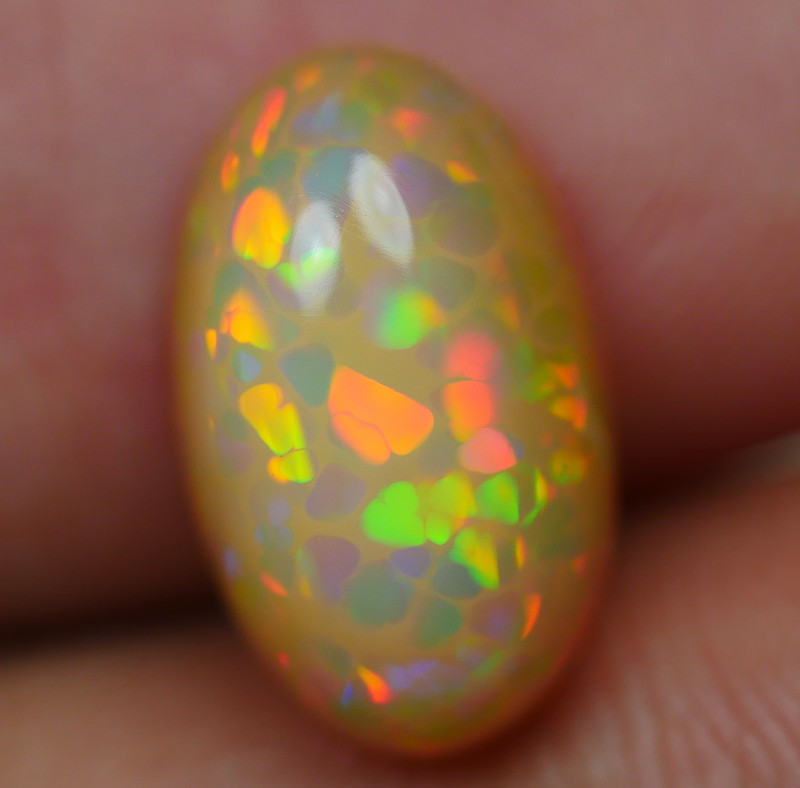
Ethiopian opals are unique in their varied, vivid patterns, ranging from Welo Broad Flash to Fire Cloud! The most sought-after pattern is honeycomb, a pattern exclusive to Ethiopian opal where common opal forms a line with web-like inclusions across the stone. Stones with honeycomb patterns are typically cut as cabochons.
Brightness
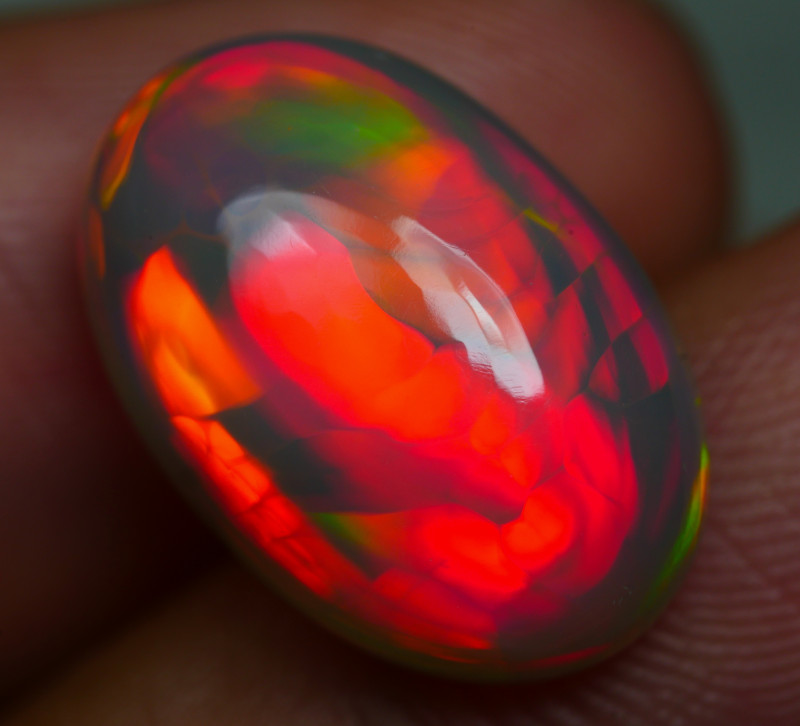
Brightness refers to a stone’s “fire,” or the colorful flashes caused by light dispersion. The fire within many Ethiopian opals shows a rare 3-dimensional effect. Color-wise, blue and green color flashes are typical, though the rare red flash may occur. In general, stones with brighter, more saturated fire command higher prices.
Treatments
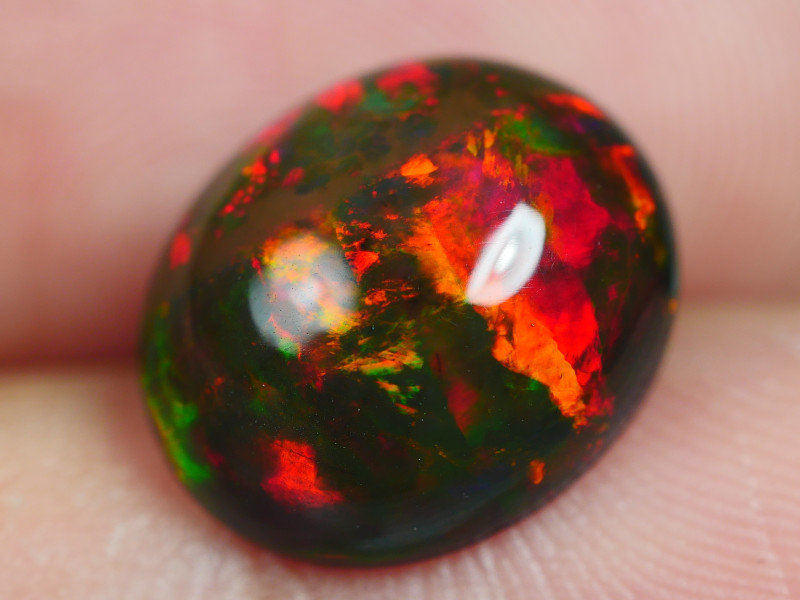
A fair amount of Ethiopian opals have been treated. Besides basic filling treatments to reduce crazing, the three primary techniques are sugar-acid, smoking, and dyeing.
A sugar-acid treatment involves soaking the opal in sugar-water, then sulphuric acid. The result is a collection of specks and stains on the surface that darken the body tone, thereby increasing the color play’s brightness.
The smoke treatment produces similar results. This process requires wrapping the opal in paper, heating it in an enclosed container, then cooling and washing it. Hydrophane opals take smoke treatments well, but this makes it harder to detect.
Ethiopian opals’ hydrophane nature also lends well to dyeing, commonly seen on bright purple or pink Ethiopian opals, as these don’t occur naturally.
Color

Ethiopian opals can be white, black, blue, red, pink, orange, or brown, depending on the mine. Colorless crystal opals come from the Wegel Tena mine.
Body tone isn’t as crucial to Ethiopian opal value as it is for, say, black opals. The main significance of body color is its effect on the stone’s brightness and patterns.
Which color you’ll see in Ethiopian opals partly depends on the province it’s from, a fundamental part of the stone’s history!
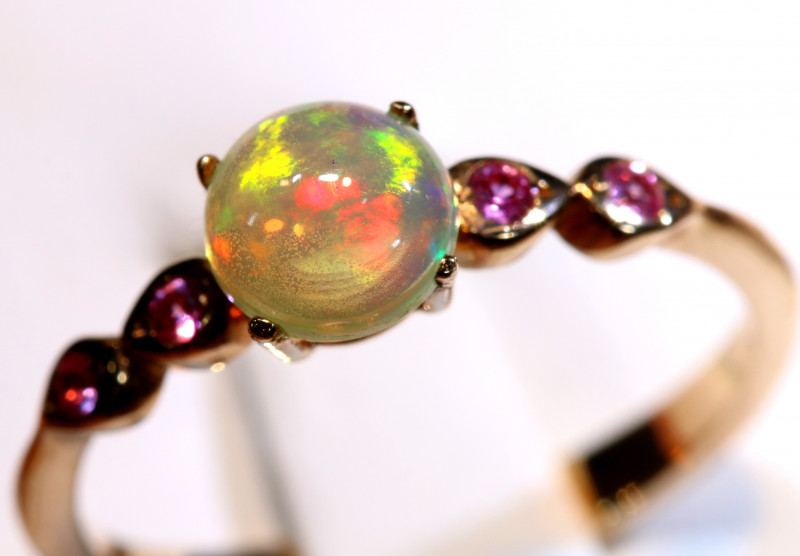
Ethiopian Opal History
The modern discovery of Ethiopian opals only occurred over the last few decades. However, the oldest opals found in a Kenyan cave dating back to roughly 4000 BC were likely Ethiopian opals! Anthropologists believe man’s earliest ancestors used these opals to make tools.
Our prehistoric ancestors didn’t call them “opals,” though. The name “opal” comes from the ancient Sanskrit Upala, meaning “precious stone,” and later Greek Opallios meaning “to see a change in color.”
Fast forward to 1994: miners discovered the first Ethiopian opal deposit in the Shewa province. These precious opals were inside volcanic rock nodules and had brown, reddish-brown, or orange coloring. Unfortunately, they also were prone to crazing.
In 2008, miners discovered a second deposit in the Wollo province near Wegel Tena. Wegel Tena opals were more durable than Shewa opals and came in more attractive types like white, crystal, fire, and the occasional black opals. “Welo opal” soon became a trade name for this deposit’s opals.
Interestingly, Wegel Tena’s white opals have a high barium content, along with inclusions of pyrite and carbon at times. Some specimens also have “digit” patterns, where layers of common and precious opal make the color play appear in finger-like columns.
The last major discovery in 2013 occurred at the Stayish mine, also in the Wollo province. Some specimens produced were white or crystal opal, but the majority were black or dark gray opal.
Today, the Wegel Tena deposit is known for stunning white and crystal opal, while the Stayish mine is known for its black opal.
Ethiopian opal’s play-of-color is generally stronger than that of Australian opal, and the horizontal tunnels make for easier mining than vertical shafts. Ethiopian miners have already produced more than 1,500kg (3,300lbs) of rough Ethiopian opal!
Geology aside, what does opal mean spiritually?
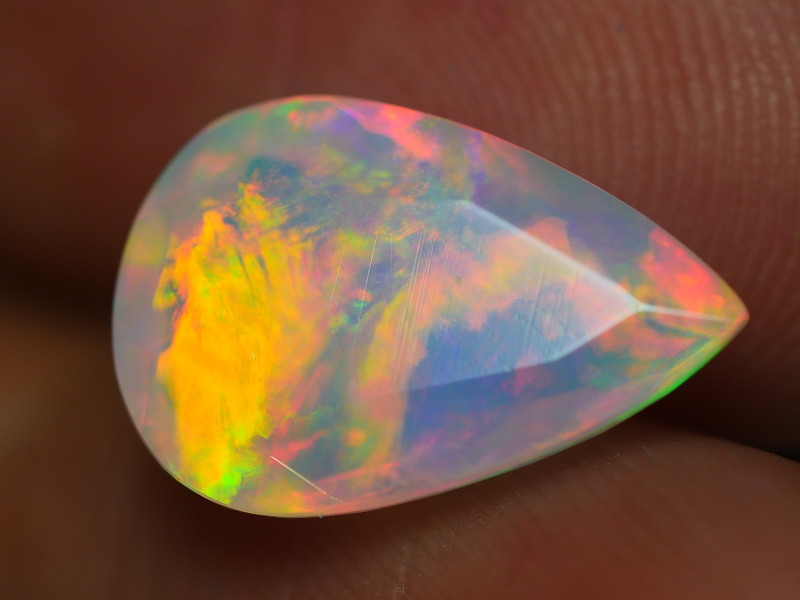
Ethiopian Opal Meaning & Symbolism
Like other opal gemstones, Ethiopian opal symbolizes hope, luck, and innocence. Additionally, these stones represent enthusiasm and creativity.
What about the Ethiopian fire opal meaning?
Fire opals symbolize passion, warmth, and love. They represent deep emotional healing and trust in everything happening for a reason. When given as a gift, these stones are a symbol of loyalty and friendship.
Coming from Ethiopia, these gems already possess rich cultural history. Called the “land of origins,” Ethiopia is where the first humans lived, the first coffee came from, and the only African nation with its own writing system.
Other cultures have also adopted their own Ethiopian opal spiritual meanings. Arabic folklore tells of opals coming from heaven through flashes of lightning, while Aztecs used opals for protection against curses like the evil eye.
What are the mystical properties of opal today?
What Are Ethiopian Opals Good For?
Ethiopian opal’s physical properties parallel many of its healing properties, particularly in its hydrophane composition and color flashes.
Just as these hydrophane opals absorb water, they can help with dehydration, water retention, and fatigue. These stones can also purportedly improve eye, hair, and skin health!
Emotionally, Ethiopian opal benefits anyone who struggles with indecision, communication, or pessimism. The stone’s bright color flashes remind you to embrace your strengths, let go of negativity, and pursue creative endeavors.
The spiritual side of Ethiopian opal is enlightening, bringing purifying properties that can help you feel more content. An Ethiopian opal affirmation to meditate on is: “I am cleansed of the past and ready for the future.”
Ethiopian Opal Chakra
For chakra healing, Ethiopian opal connects to the crown chakra. Located above the head, this chakra rules self-realization and spirituality.
When the crown is blocked, you may feel unstable or resistant to growth. Ethiopian opal can open the chakra, bringing wisdom and spiritual connection with the universe.
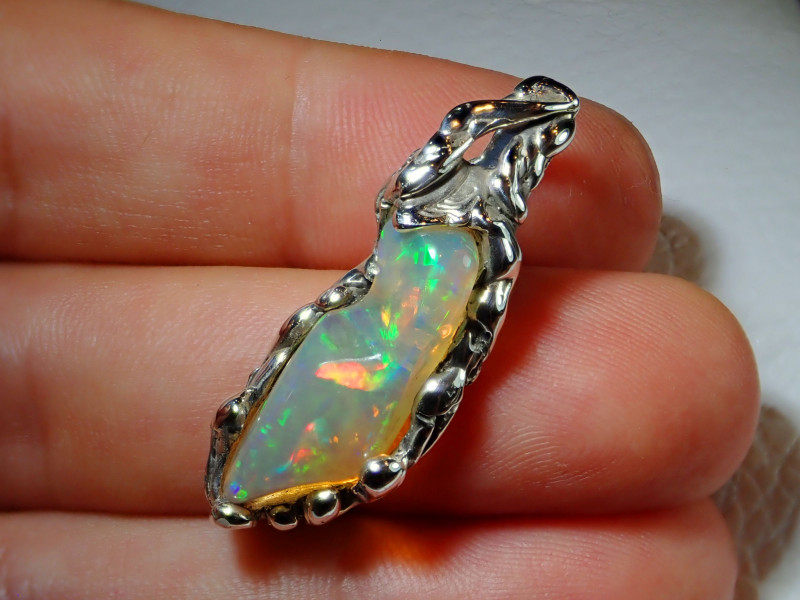
Enchanted By Ethiopian Opal?
Whether you prefer black, white, or fire opal, you can find everything you desire and more in Ethiopian opals. Given its rich history and healing properties, wearing an Ethiopian opal ring is a perfect way to celebrate your October birthday or simply show off your unique style!
Was this article helpful?
17 people found this article helpfulRoss Sedawie
- Written - 2nd Jan 2011
- Edited - 3rd Jan 2023

Did you know?

Opal Auctions Verified Sellers








![2.20 CTS BLACK OPAL STONE-MORE ORANGE IN THE STONE. - [LRO2765]](https://liveplatforms-production.b-cdn.net/tenants/oa/uploads/images/1185000-1189999/1187766/8f3ccb93-a63e-4ec6-a03b-ea550a2de0c0.jpg?width=480&aspect_ratio=1001%3A1000&auto_optimize=medium)






